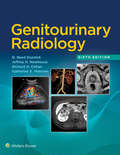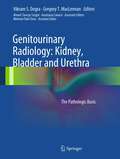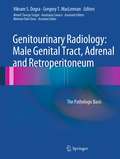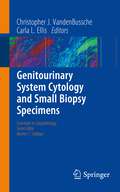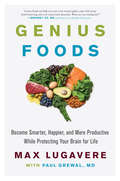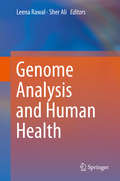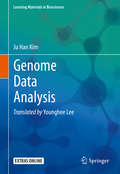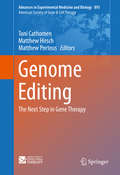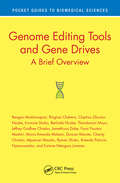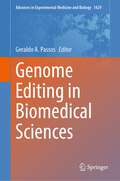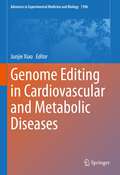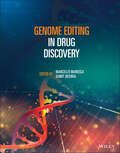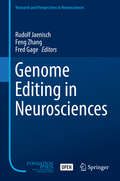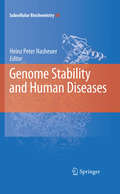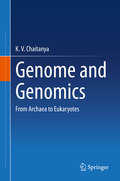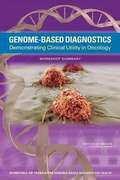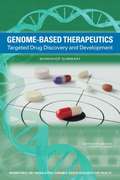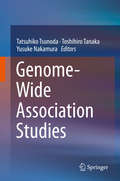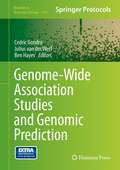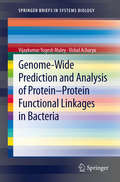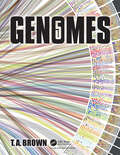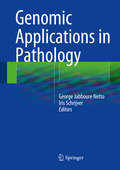- Table View
- List View
Genitourinary Pathology
by Cristina Magi-Galluzzi Christopher G. PrzybycinThis book provides a comprehensive, state-of-the art review of the genitourinary tumor pathology field and the most contemporary insights regarding specimen submission, histologic morphology, immunohistochemistry, and molecular studies useful in the diagnosis of genitourinary neoplasms. Discussion of the clinical implications of pathological findings is contributed by renowned clinicians in the field. This handsome volume guides the reader through the intricacies of genitourinary tumor pathology, diagnosis, reporting, and prognosis. Written by experts in the field, Genitourinary Pathology: Practical Advances is of great value to anatomic pathologists, urologists, fellows in genitourinary pathology, as well as upper level residents training in pathology.
Genitourinary Radiology
by N. Reed Dunnick Jeffrey H. Newhouse Richard H. Cohan Katherine E. MaturenPreviously known as the Textbook of Uroradiology, the newly retitled Genitourinary Radiology continues to bring you top-flight expertise in interpreting imaging studies of the genitourinary tract. A team of leading authorities walks you through the full range of relevant modalities and findings for each anatomical region, providing a multitude of high-quality representative images that capture the characteristic appearance of the conditions you’re likely to encounter. The result remains an indispensable resource for diagnosing genitourinary diseases and disorders.
Genitourinary Radiology: Kidney, Bladder and Urethra
by Vikram S. Dogra Gregory T. MaclennanA book such as this, correlating radiologic findings with the associated gross and microscopic pathologic findings, has never been offered to the medical community. It contains radiologic images, in a variety of formats (ultrasound, CT scan, MRI scan) correlated with gross photos and photomicrographs of a wide spectrum of pathologic entities, including their variants, occurring in the following organs or anatomic sites. This book would be of particular interest to radiologists and radiologists-in training, who naturally are very cognizant of radiologic abnormalities, but who rarely, if ever, encounter visual images of the pathologic lesions that they diagnose. It will also be of interest to pathologists and pathologists-in-training, urologists, GU radiation oncologists, and GU medical oncologists.
Genitourinary Radiology: Male Genital Tract, Adrenal and Retroperitoneum
by Vikram S. Dogra Gregory T. Maclennan Ahmet Tuncay Turgut Anastasia Canacci Mehmet Ruhi OnurGenitourinary Radiology: Male Genital Tract, Adrenal and Retroperitoneum: The Pathologic Basis is the second volume in a set of books on the pathologic basis of genitourinary radiology. Genitourinary Radiology: Male Genital Tract, Adrenal and Retroperitoneum: The Pathologic Basis provides a lavishly illustrated guide to the radiologic and pathologic features of a broad spectrum of diseases of the male genital tract, adrenal glands and retroperitoneum, including the entities most commonly encountered in day to day practice. The editors are authorities in the fields of genitourinary radiology and pathology, and the authors of each chapter are renowned radiologists, with pathology content provided by an internationally recognized genitourinary pathologist. General, plain film, intravenous pyelography, ultrasound, computed tomography, magnetic resonance imaging, nuclear medicine imaging and PET imaging of each disease entity are included. Accompanying the majority of the radiological narratives are complementary descriptions of the gross and microscopic features of the disease entities. Genitourinary Radiology: Male Genital Tract, Adrenal and Retroperitoneum: The Pathologic Basis is aimed at radiologists in private and academic practice, radiology residents, urologists, urology trainees, pathology trainees and fellows specializing in genitourinary pathology. Both experts and beginners can use this excellent reference book to enhance their skills in the fields of genitourinary radiology and pathology.
Genitourinary System Cytology and Small Biopsy Specimens (Essentials in Cytopathology #29)
by Christopher J. VandenBussche Carla L. EllisThis book covers the full spectrum of benign and malignant conditions of the genitourinary tract with emphasis on common entities encountered in daily practice. The volume is heavily illustrated and contains useful algorithms that guide the reader through the differential diagnosis and cyto-histologic correlation of common and uncommon entities with appropriate clinical correlations. This book will serve as a valuable quick reference for pathologists, cytopathologists, cytotechnologists, fellows and residents in the field. Genitourinary system cytopathology specimens and small biopsies are common specimens, with a growing number of renal fine needle aspirations and core biopsy procedures being performed each year. Genitourinary System Cytology and Small Biopsy Specimens focuses on the correlation between urinary tract cytology and surgical pathology, including the evaluation of germ cell tumor metastasis to distant sites. Aspiration and exfoliative cytology samples obtained from all areas of and related to the genitourinary tract are highlighted in individualized chapters for these entities. The growing body of information in personalized medicine and molecular discoveries in the field of genitourinary pathology demands focus as well; hence an integrated approach to molecular diagnostics is presented in each chapter. In summary, this book will provide an illustrative and algorithmic approach to every day practice of genitourinary cytopathology and small biopsy material, using appropriate cytologic-histologic correlation format and incorporating recent updates in terminology, guidelines, and ancillary studies.
Genius Foods: Become Smarter, Happier, and More Productive While Protecting Your Brain for Life
by Max Lugavere Paul GrewalDiscover the critical link between your brain and the food you eat and change the way your brain ages, in this cutting-edge, practical guide to eliminating brain fog, optimizing brain health, and achieving peak mental performance from media personality and leading voice in health Max Lugavere. After his mother was diagnosed with a mysterious form of dementia, Max Lugavere put his successful media career on hold to learn everything he could about brain health and performance. For the better half of a decade, he consumed the most up-to-date scientific research, talked to dozens of leading scientists and clinicians around the world, and visited the country’s best neurology departments—all in the hopes of understanding his mother’s condition. Now, in Genius Foods, Lugavere presents a comprehensive guide to brain optimization. He uncovers the stunning link between our dietary and lifestyle choices and our brain functions, revealing how the foods you eat directly affect your ability to focus, learn, remember, create, analyze new ideas, and maintain a balanced mood. Weaving together pioneering research on dementia prevention, cognitive optimization, and nutritional psychiatry, Lugavere distills groundbreaking science into actionable lifestyle changes. He shares invaluable insights into how to improve your brain power, including the nutrients that can boost your memory and improve mental clarity (and where to find them);the foods and tactics that can energize and rejuvenate your brain, no matter your age;a brain-boosting fat-loss method so powerful it has been called “biochemical liposuction”; andthe foods that can improve your happiness, both now and for the long term.With Genius Foods, Lugavere offers a cutting-edge yet practical road map to eliminating brain fog and optimizing the brain’s health and performance today—and decades into the future.
Genius Kitchen: Over 100 Easy and Delicious Recipes to Make Your Brain Sharp, Body Strong, and Taste Buds Happy (Genius Living #3)
by Max LugavereCombining the dietary recommendations in his bestselling Genius Foods and the lifestyle recommendations of The Genius Life, Genius Kitchen features shockingly delicious, nutrient-packed recipes that will energize your mind, strengthen your body, and pave a path to health that you’ll feel with the first bite. Max Lugavere’s debut book Genius Foods was groundbreaking, providing much-needed information on brain health that was embraced by thousands, and became an instant New York Times bestseller. His second book, The Genius Life, introduced an easy-to-implement protocol for strengthening your body and mind. This is the follow-up fans have been waiting for: the companion cookbook, filled with over 100 delicious recipes to help you lose weight, feel great, and reach optimum health.Inspired by traditions from around the globe, the 100-plus recipes and stunning photographs in Genius Kitchen feature an international twist, with bold flavors that favor simplicity and quality of ingredients over complexity and quantity. In addition, Max lists the basic, healthy ingredients and tools that are essential for a well-stocked kitchen and pantry, and offers techniques and best practices for healthy cooking and eating well on a budget. Max wants everyone to be well and enjoy great food—a legacy imparted on him by the tragic health of his mother. Part cookbook, part wellness guide, Genius Kitchen provides key insights that make healthy eating a breeze. Max explains the importance of whole, fresh foods, how various nutrients work together keep you healthy, and how to get fit without counting calories. Breaking down each meal component, Max explains the art and science of nutrition without the dogma, so that you can feel your best every day without sacrificing your love of eating. Whether you are a novice cook or seasoned in the kitchen; just beginning the journey to wellness, or health conscious but wanting to up your game, everyone will benefit from the information presented in Genius Kitchen—and enjoy some epic food in the process.
Genome Analysis and Human Health
by Leena Rawal Sher AliThis book highlights selected current data and its relevance in the human health care system, offering a fundamental primer on genetics and human health. With the advent of new high-throughput technologies (for the whole genome including exome sequencing), the conventional focus on genetics and individual genes is now shifting toward the analysis of complex genes, gene-gene interactions and the association between genes and environment, including epigenetics. The rapidly changing scientific research landscape, with the ever-growing influx of data on one hand and emergence of newer and more complicated diseases on the other, has created a dilemma for researchers and caregivers, who are still hopeful that advances in genetics and genomics will provide avenues for the understanding, prevention and possible cure of human diseases. The book focuses on the interactions between genes and proteins at both the transcriptome and proteome levels, which in turn affect the human genome and health. Additionally, it covers the domain that must be explored in order to understand the gene-gene and protein-protein interactions that contribute to human health. The book offers a valuable guide for all students and researchers working in the area of molecular genetics and genomics.
Genome Data Analysis (Learning Materials in Biosciences)
by Ju Han KimThis textbook describes recent advances in genomics and bioinformatics and provides numerous examples of genome data analysis that illustrate its relevance to real world problems and will improve the reader’s bioinformatics skills. Basic data preprocessing with normalization and filtering, primary pattern analysis, and machine learning algorithms using R and Python are demonstrated for gene-expression microarrays, genotyping microarrays, next-generation sequencing data, epigenomic data, and biological network and semantic analyses. In addition, detailed attention is devoted to integrative genomic data analysis, including multivariate data projection, gene-metabolic pathway mapping, automated biomolecular annotation, text mining of factual and literature databases, and integrated management of biomolecular databases. The textbook is primarily intended for life scientists, medical scientists, statisticians, data processing researchers, engineers, and other beginners in bioinformatics who are experiencing difficulty in approaching the field. However, it will also serve as a simple guideline for experts unfamiliar with the new, developing subfield of genomic analysis within bioinformatics.
Genome Editing
by Toni Cathomen Matthew Hirsch Matthew PorteusThis comprehensive volume explores human genetic engineering its pre-clinical and clinical applications, current developments, and as treatment for hereditary diseases. It presents and evaluates the most recent advances in the understanding of mammalian host DNA repair mechanisms, such as double-strand break induced gene targeting and mutagenesis, the development of zinc-finger nucleases, genome editing for neuromuscular diseases, phase integrases, triplex forming oligonucleotides and peptide nucleic acids, aptamer-guided gene targeting, AAV gene editing via DSB repair, engineered nucleases and trinucleotide repeat diseases, and creation of HIV-resistant cells. The expertly authored chapters contextualize current developments within the history of genome editing while also discussing the current and potential safety concerns of this rapidly growing field. Genome Editing: The Next Step in Gene Therapy, the latest volume in the American Society of Gene and Cell Therapy series, deftly illuminates the potential of genetic engineering technology to eradicate today's deadliest and most prolific diseases. It is ideal reading for clinicians and researchers in genetics and immunology.
Genome Editing Tools and Gene Drives: A Brief Overview (Pocket Guides to Biomedical Sciences)
by Reagan Mudziwapasi Ringisai Chekera Clophas Zibusiso Ncube Irvonnie Shoko Berlinda Ncube Thandanani Moyo Jeffrey Godfrey Chimbo Jemethious Dube Farai Faustos Mashiri Moira Amanda Mubani Duncan Maruta Charity Chimbo Mpumuzi Masuku Ryman Shoko Rutendo Patricia Nyamusamba Fortune Ntengwa JomaneGenome-editing methods are becoming routine tools for molecular and cell biologists. Such tools include ZFNs, CRISPR, megaTALs and TALENs. These tools are revolutionizing the creation of precisely manipulated genomes to modify the characteristics of organisms or cells. Additionally, gene drives have altered the way we understand inheritance laws. They give us the ability to have total control of the inheritance of traits of choice and importance. This succinct volume summarizes the history, principles and applications – as well as the advantages and disadvantages – of each of these tools and various kinds of gene drives. The book is part of a program to produce books helpful to students and faculties of science at colleges and universities. This volume in the Pocket Guides to Biomedical Sciences series will help demystify these technologies. The book fills the gap between established conventional methods and the novel and exciting newly introduced tools of genome editing and gene drives. It will help young scientists understand the emerging genome-editing tools and gene drives, thereby promoting related research and adoption. Key Features Extensively reviews the current genome-editing tools and gene drives Clarifies the targeting mechanisms and specificity of genome-editing tools Details many different types of natural and synthetic gene drives Highlights concerns with gene drives and genome-editing tools Related Titles Brown, T. A. Genomes 4 (ISBN 978-0-8153-4508-4) Samuelsson, T. The Human Genome in Health and Disease: A Story in Four Letters (ISBN 978-0-8153-4591-6) Soh, J., et al. Genome Annotation (ISBN 978-1-4398-4117-4)
Genome Editing in Biomedical Sciences (Advances in Experimental Medicine and Biology #1429)
by Geraldo A. PassosThis volume focuses on applying the Crispr system in editing the genome of human cells (in vitro and in vivo) and model organisms used in biomedical research. With the advent of Crispr technology, genome editing soon became a procedure of great interest to laboratories worldwide due to its relative ease and accuracy. In biomedical sciences, genome editing by Crispr has already enabled the development of new experimental model systems. In medicine, therapeutic alternatives for the genetic "correction" of diseases have already begun to appear. Therefore, the book's purpose is to bring in a single volume, chapters that show the scientific community in biomedicine, medicine, human genetics, oncology, virology, and parasitology, among others, the advances in genomic editing. In a chapter dedicated to the ethical aspects of human genomic editing, we also address what we can and should do with this (bio)technology. The book chapters were written by productive researchers specializing in Crispr genome editing. The chapters cover the concept of Crispr and genome editing and how to use this new methodology in biomedical research and medicine, among other aspects, including the ethical controversy around its use in humans. The writing of the chapters keeps a specialized language intelligible enough for those who want to introduce themselves to the subject.
Genome Editing in Cardiovascular and Metabolic Diseases (Advances in Experimental Medicine and Biology #1396)
by Junjie XiaoThis book provides the latest research progress on genome editing in cardiovascular and metabolic diseases and includes bioinformatics research methodology of genome editing. Genome editing is a genetic engineering technique precisely modified specific target genes of organism genome, which has been applied to basic theoretical research and production applications from plants and animals to gene therapy of human beings. Cardiovascular and metabolic diseases have become major factors affecting human health worldwide. This book contains information about bioinformatics, genome editing in cardiovascular diseases, genome editing in metabolic diseases and therapeutic effects. It will be useful for biologist, cardiologist, cardiovascular surgeons, endocrinologist, internists, nurses, undergraduate and graduate students in medicine and cell biology and others interested in cardiovascular and metabolic medicine.
Genome Editing in Drug Discovery
by Sumit Deswal Marcello MarescaGENOME EDITING IN DRUG DISCOVERY A practical guide for researchers and professionals applying genome editing techniques to drug discovery In Genome Editing in Drug Discovery, a team of distinguished biologists delivers a comprehensive exploration of genome editing in the drug discovery process, with coverage of the technology’s history, current issues and techniques, and future perspectives and research directions. The book discusses techniques for disease modeling, target identification with CRISPR, safety studies, therapeutic editing, and intellectual property issues. The safety and efficacy of drugs and new target discovery, as well as next-generation therapeutics are also presented. Offering practical suggestions for practitioners and academicians involved in drug discovery, Genome Editing in Drug Discovery is a fulsome treatment of a technology that has become part of nearly every early step in the drug discovery pipeline. Selected contributions also include: A thorough introduction to the applications of CRISPRi and CRISPRa in drug discovery Comprehensive explorations of genome-editing applications in stem cell engineering and regenerative medicine Practical discussions of the safety aspects of genome editing with respect to immunogenicity and the specificity of CRISPR-Cas9 gene editing In-depth examinations of critical socio-economic and bioethical challenges in the CRISPR-Cas9 patent landscape Perfect for academic researchers and professionals in the biotech and pharmaceutical industries, Genome Editing in Drug Discovery will also earn a place in the libraries of medicinal chemists, biochemists, and molecular biologists.
Genome Editing in Neurosciences
by Feng Zhang Rudolf Jaenisch Fred GageThis book is open access under a CC BY 4. 0 license. CRISPR-Cas9 is a rapid, efficient, versatile and relatively cheap method for dissecting the molecular pathways that are the basis of life, as well as for investigating and potentially rectifying faults in these pathways that result in disease. This book reviews how CRISPR-Cas9 and other genome editing techniques are advancing our understanding of development and function in the nervous system, uncovering the molecular causes of neurological disorders and providing tools for gene therapy.
Genome Stability and Human Diseases
by Heinz-Peter NasheuerSince the establishment of the DNA structure researchers have been highly interested in the molecular basis of the inheritance of genes and of genetic disorders. Scientific investigations of the last two decades have shown that, in addition to oncogenic viruses and signalling pathways alterations, genomic instability is important in the development of cancer. This view is supported by the findings that aneuploidy, which results from chromosome instability, is one of the hallmarks of cancer cells. Chromosomal instability also underpins our fundamental principles of understanding tumourigenesis: It thought that cancer arises from the sequential acquisition of genetic alterations in specific genes. In this hypothesis, these rare genetic events represent rate-limiting 'bottlenecks' in the clonal evolution of a cancer, and pre-cancerous cells can evolve into neoplastic cells through the acquisition of somatic mutations. This book is written by international leading scientists in the field of genome stability. Chapters are devoted to genome stability and anti-cancer drug targets, histone modifications, chromatin factors, DNA repair, apoptosis and many other key areas of research. The chapters give insights into the newest development of the genome stability and human diseases and bring the current understanding of the mechanisms leading to chromosome instability and their potential for clinical impact to the reader.
Genome and Genomics: From Archaea to Eukaryotes
by K. V. ChaitanyaThis book provides a detailed and up-to-dated information on the genomes belonging to three major life forms on Earth – archaea, prokaryotes and eukaryotes. Each section describes about the genome of a specific group of organisms, such as viruses, archaea, bacteria, eukaryotes and organellar genomes. Individual chapters provide details of their organization, structure, evolution, sequencing strategies and functions. Further, this book discusses the technologies that are applied for genome sequencing; assembly, annotation and gene prediction. Other topics include the genomes of important model organisms, mitochondria genome of Neanderthal fossil, etc. This book also examines the evolution of chloroplast and mitochondria genomes by comparing with bacteria, addresses the diseases that occur in humans due to the mutations in mitochondrial genome, gene therapy and engineering of chloroplast and mitochondrial genomes. Lastly, it features an overview of the role of proteomics, exposomics, connectomics, metabolomics, and microbiomics. This book is a fascinating read for students, lecturers and researchers in the field of genetics, genomics, microbiology and life sciences.
Genome-Based Diagnostics
by Institute of Medicine Steve Olson Board on Health Sciences Policy Adam C. Berger Roundtable on Translating Genomic-Based Research for Health Center for Medical Technology PolicyGenome-Based Diagnostics: Demonstrating Clinical Utility in Oncology is the summary of a workshop convened in May 2012 by the Roundtable on Translating Genomic-Based Research for Health and the Center for Medical Technology Policy of the Institute of Medicine to foster the identified need for further sustained dialogue between stakeholders regarding the clinical utility of molecular diagnostics. The workshop brought together a wide range of stakeholders, including patients, health care providers, policy makers, payers, diagnostic test developers, researchers, and guideline developers, to identify the challenges and opportunities in advancing the development and use of molecular diagnostic tests designed to guide the treatment and management of patients with cancer. The sequencing of the human genome has greatly accelerated the process of linking specific genetic variants with disease. These findings have yielded a rapidly increasing number of molecular diagnostic tests designed to guide disease treatment and management. Many of these tests are aimed at determining the best treatments for specific forms of cancer, making oncology a valuable testing ground for the use of molecular diagnostic tests in medicine in general. Nevertheless, many questions surround the clinical value of molecular diagnostic tests, and their acceptance by clinicians, payers, and patients has been unpredictable. A major limiting factor for the use of these tests has been the lack of clear evidence of clinical utility. Genome-Based Diagnostics assesses the evidentiary requirements for clinical utility of molecular diagnostics used to guide treatment decisions for patients with cancer; discusses methodologies related to demonstrating these evidentiary requirements that meet the needs of all stakeholders; and considers innovative, sustainable research collaborations for generating evidence of clinical utility involving multiple stakeholders.
Genome-Based Therapeutics
by Institute of Medicine Steve Olson Board on Health Sciences Policy Adam C. Berger Roundtable on Translating Genomic-Based Research for HealthThe number of new drug approvals has remained reasonably steady for the past 50 years at around 20 to 30 per year, while at the same time the total spending on health-related research and development has tripled since 1990. There are many suspected causes for this trend, including increases in regulatory barriers, the rising costs of scientific inquiry, a decrease in research and development efficiency, the downstream effects of patient expirations on investment, and the lack of production models that have successfully incorporated new technology. Regardless, this trajectory is not economically sustainable for the businesses involved, and, in response, many companies are turning toward collaborative models of drug development, whether with other industrial firms, academia, or government. Introducing greater efficiency and knowledge into these new models and aligning incentives among participants may help to reverse the trends highlighted above, while producing more effective drugs in the process. Genome-Based Therapeutics explains that new technologies have the potential to open up avenues of development and to identify new drug targets to pursue. Specifically, improved validation of gene-disease associations through genomics research has the potential to revolutionize drug production and lower development costs. Genetic information has helped developers by increasing their understanding of the mechanisms of disease as well as individual patients' reactions to their medications. There is a need to identify the success factors for the various models that are being developed, whether they are industry-led, academia-led, or collaborations between the two. Genome-Based Therapeutics summarizes a workshop that was held on March 21, 2012, titled New Paradigms in Drug Discovery: How Genomic Data Are Being Used to Revolutionize the Drug Discovery and Development Process. At this workshop the goal was to examine the general approaches being used to apply successes achieved so far, and the challenges ahead.
Genome-Wide Association Studies
by Yusuke Nakamura Tatsuhiko Tsunoda Toshihiro TanakaThis book examines the utility of genome-wide association studies (GWAS) in the era of next-generation sequencing and big data, identifies limitations and potential means of overcoming them, and looks to the future of GWAS and what may lay beyond. GWAS are among the most powerful tools for elucidating the genetic aspects of human and disease diversity. In Genome-Wide Association Studies, experts in the field explore in depth the impacts of GWAS on genomic research into a variety of common diseases, including cardiovascular, autoimmune, diabetic, cancer, and infectious diseases. The book will equip readers with a sound understanding both of the types of disease and phenotypes that are suited for GWAS and of the ways in which a road map resulting from GWAS can lead to the realization of personalized/precision medicine: functional analysis, drug seeds, pathway analysis, disease mechanism, risk prediction, and diagnosis.
Genome-Wide Association Studies and Genomic Prediction
by Ben Hayes Cedric Gondro Julius van der WerfWith the detailed genomic information that is now becoming available, we have a plethora of data that allows researchers to address questions in a variety of areas. Genome-wide association studies (GWAS) have become a vital approach to identify candidate regions associated with complex diseases in human medicine, production traits in agriculture, and variation in wild populations. Genomic prediction goes a step further, attempting to predict phenotypic variation in these traits from genomic information. Genome-Wide Association Studies and Genomic Prediction pulls together expert contributions to address this important area of study. The volume begins with a section covering the phenotypes of interest as well as design issues for GWAS, then moves on to discuss efficient computational methods to store and handle large datasets, quality control measures, phasing, haplotype inference, and imputation. Later chapters deal with statistical approaches to data analysis where the experimental objective is either to confirm the biology by identifying genomic regions associated to a trait or to use the data to make genomic predictions about a future phenotypic outcome (e.g. predict onset of disease). As part of the Methods in Molecular Biology series, chapters provide helpful, real-world implementation advice.
Genome-Wide Prediction and Analysis of Protein-Protein Functional Linkages in Bacteria
by Vishal Acharya Vijaykumar Yogesh MuleyUsing genome sequencing, one can predict possible interactions among proteins. There are very few titles that focus on protein-protein interaction predictions in bacteria. The authors will describe these methods and further highlight its use to predict various biological pathways and complexity of the cellular response to various environmental conditions. Topics include analysis of complex genome-scale protein-protein interaction networks, effects of reference genome selection on prediction accuracy, and genome sequence templates to predict protein function.
Genome: The Story of the Most Astonishing Scientific Adventure of Our Time - The Attempt to Map All the Genes in the Human Body
by Jerry E. Bishop Michael WaldholzBy far the best popular work written about the impact of molecular biology on science. An incisive, thoughtful and thorough work that educates and entertains.
Genomes 5
by Terry A. BrownGenomes 5 has been completely revised and updated. It is a thoroughly modern textbook about genomes and how they are investigated. As with previous Genomes editions, techniques come first, then genome anatomies, followed by genome function, and finally genome evolution. The genomes of all types of organism are covered: viruses, bacteria, fungi, plants, and animals, including humans and other hominids. Genome sequencing and assembly methods have been thoroughly revised to include new developments in long-read DNA sequencing. Coverage of genome annotation emphasizes genome-wide RNA mapping, with CRISPR-Cas 9 and GWAS methods of determining gene function covered. The knowledge gained from these techniques forms the basis of the chapters that describe the three main types of genomes: eukaryotic, prokaryotic (including eukaryotic organelles), and viral (including mobile genetic elements). Coverage of genome expression and replication is truly genomic, concentrating on the genome-wide implications of DNA packaging, epigenome modifications, DNA-binding proteins, non-coding RNAs, regulatory genome sequences, and protein-protein interactions. Also included are examples of the applications of metabolomics and systems biology. The final chapter is on genome evolutionn, including the evolution of the epigenome, using genomics to study human evolution, and using population genomics to advance plant breeding. Established methods of molecular biology are included if they are still relevant today and there is always an explanation as to why the method is still important. Genomes 5 is the ideal text for upper-level courses focused on genomes and genomics. Key Features A highly accessible and well-structured book with chapters organized into four parts to aid navigation Superb artwork illustrates the key concepts and mechanisms Each chapter has a set of short-answer questions and in-depth problems to test the reader’s understanding of the material Thoroughly up to date with references to the latest research from the 2020s
Genomic Applications in Pathology
by Iris Schrijver George Jabboure NettoGenomic Applications in Pathology provides a state-of-the art review of the scientific principles underlying next generation genomic technologies and the required bioinformatics approaches to analyses of the daunting amount of data generated by current and emerging genomic technologies. Implementation roadmaps for various clinical assays such as single gene, gene panels, whole exome and whole genome assays are discussed together with issues related to reporting, including the pathologist's role in interpretation and clinical integration of genomic tests results. Genomic applications for site-specific solid tumors and hematologic neoplasms are detailed, as well as genomic applications in pharmacogenomics, inherited genetic diseases, and infectious diseases. The latest iteration of practice recommendations and guidelines in genomic testing, put forth by stakeholder professional organizations such as the Association for Molecular Pathology and the College of American Pathologists, are also discussed in the volume, as well as regulatory issues and laboratory accreditation related to genomic testing. Written by experts in the field, Genomic Applications in Pathology provides a comprehensive resource that is of great value to practicing molecular pathologists, hematopathologists, other subspecialized pathologists, general pathologists, pathology trainees, oncologists, and geneticists.

